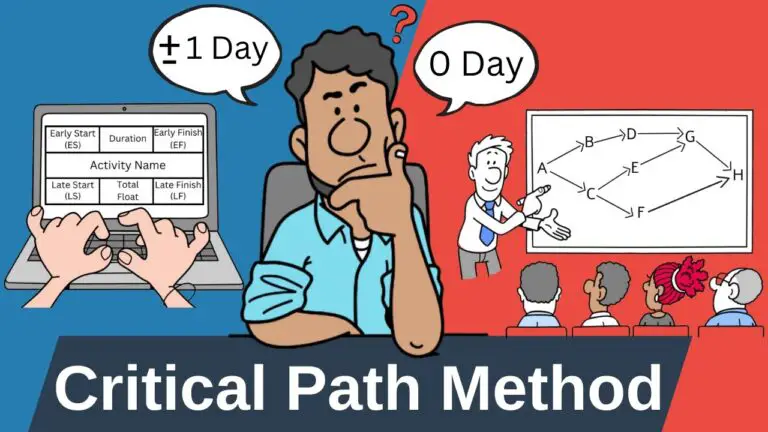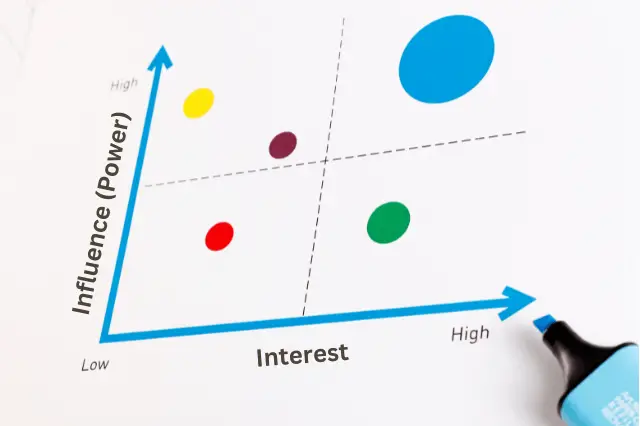Last Updated on April 17, 2025 by andrewshih
SWOT analysis is a simple yet powerful tool that helps project managers evaluate the factors that impact their projects.
By identifying Strengths, Weaknesses, Opportunities, and Threats, this analysis helps teams uncover critical insights that lead to better decision-making and project outcomes. Whether you’re in the early planning stages or monitoring progress, SWOT analysis provides clarity and direction.
In this guide, we’ll explore what SWOT analysis is and why it matters. We will provide examples, go over the steps, and a template to help you complete your own SWOT analysis.
- What is SWOT Analysis?
- Why is SWOT Analysis Important in Project Management?
- When Should You Use SWOT Analysis?
- How to Conduct a SWOT Analysis
- Templates for SWOT Analysis
- Tools for SWOT Analysis
- Integrating SWOT Analysis with Other Project Management Tools
- SWOT Analysis in Project Management Certifications
- Conclusion
- FAQ
What is SWOT Analysis?
SWOT analysis is a strategic tool that evaluates a project’s Strengths, Weaknesses, Opportunities, and Threats to provide a clear understanding of internal and external factors. It helps project managers make informed decisions, improve risk management, and align teams with project goals. By identifying actionable insights, SWOT analysis ensures better planning, resource allocation, and adaptability throughout the project lifecycle.
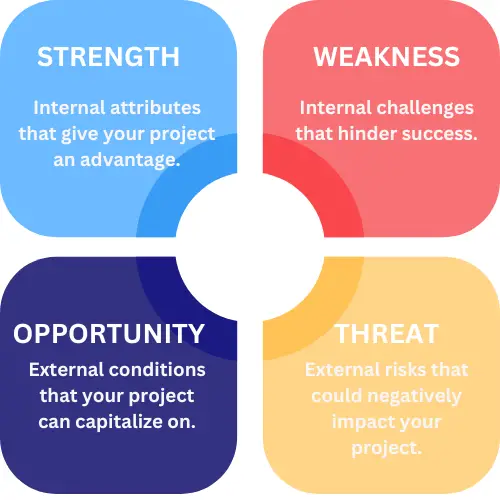
This method simplifies complex information, making it easier to develop actionable strategies.
SWOT analysis is especially valuable in project management, where understanding risks and opportunities is critical for success.
Why is SWOT Analysis Important in Project Management?
Project managers use SWOT analysis because it improves project outcomes in several ways:
- Clarifies Priorities: It highlights the most significant internal and external factors, allowing teams to focus their efforts.
- Supports Decision-Making: By understanding strengths and weaknesses, project managers can allocate resources effectively and take advantage of opportunities.
- Enhances Risk Management: It helps identify potential threats early, so teams can develop mitigation strategies.
- Improves Stakeholder Engagement: A SWOT analysis provides a clear snapshot of the project environment, which is valuable for discussions with stakeholders.
- Boosts Team Alignment: By involving team members in the process, you create a shared understanding of project goals and challenges.
SWOT analysis is a tool that helps teams stay proactive, adapt to changes, and keep projects on track.
When Should You Use SWOT Analysis?
SWOT analysis fits into multiple stages of a project:
- Initiation: Use it to assess project feasibility and identify potential risks and opportunities.
- Planning: Incorporate SWOT findings into risk management plans, resource allocation, and stakeholder strategies.
- Execution: Revisit the SWOT analysis to track how internal and external factors evolve.
- Closing: Reflect on the analysis to capture lessons learned for future projects.
This flexibility makes SWOT analysis relevant throughout the project lifecycle.
How to Conduct a SWOT Analysis
Conducting a SWOT analysis involves a structured approach. Follow these steps to get the most out of the process:
1. Gather Input from Your Team
Bring together team members, stakeholders, and subject matter experts. A diverse group provides a broad perspective and ensures you don’t miss critical insights.
2. Identify Strengths
These are internal factors that give a project or team an advantage.
Strengths might include experienced team members, strong stakeholder support, proprietary technology, or access to ample funding. Identifying strengths involves evaluating what your project does well, what resources are readily available, and what unique advantages set you apart from competitors.
Ask questions like:
- What are our core competencies as a team or organization?
- What skills or resources does our team excel in?
- What competitive advantages do we have?
- What stakeholder feedback highlights our strengths?
3. Identify Weaknesses
These are internal challenges or limitations that could hinder a project’s success.
Weaknesses could include skill gaps within the team, inefficient workflows, limited budgets, or poor communication channels. Identifying weaknesses requires an honest assessment of areas where the project may struggle, what resources are insufficient, and any recurring issues that could impact outcomes. Consider:
- Where are we lacking resources or expertise?
- What inefficiencies exist in our workflows?
- What could damage stakeholder confidence?
- What risks stem from internal gaps?
4. Identify Opportunities
These are external factors that can positively influence the project’s success.
Examples of opportunities include emerging technologies, favorable market trends, partnerships, or regulatory incentives. Identifying opportunities involves scanning the external environment to uncover possibilities that align with the project’s goals and strengths. Explore:
- What market trends or technologies can we leverage?
- Are there any emerging markets or technologies we can explore?
- Are there potential partnerships or collaborations available?
- Are there regulatory changes that favor our project?
5. Identify Threats
These are external risks or challenges that could negatively impact the project.
Threats might include rising competition, economic instability, regulatory changes, or resource shortages. Identifying threats requires evaluating external conditions that could derail the project, such as market shifts, stakeholder conflicts, or supply chain disruptions. Think about:
- Are competitors launching similar projects?
- What external challenges could derail the project?
- What environmental or economic risks exist?
- Could changes in regulations or stakeholder expectations harm the project?
6. Prioritize and Strategize
Not all findings will have the same impact. Rank the factors in each category by importance and develop strategies to:
- Maximize strengths and opportunities.
- Address weaknesses and mitigate threats.
Visualize Findings with a SWOT Matrix
Use a simple grid to display your findings. This visualization makes it easy to see connections and prioritize actions.
Examples of SWOT Analysis in Project Management
Software Development Project
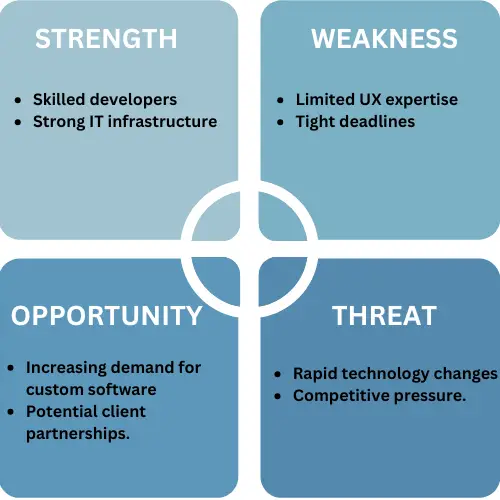
Construction Project
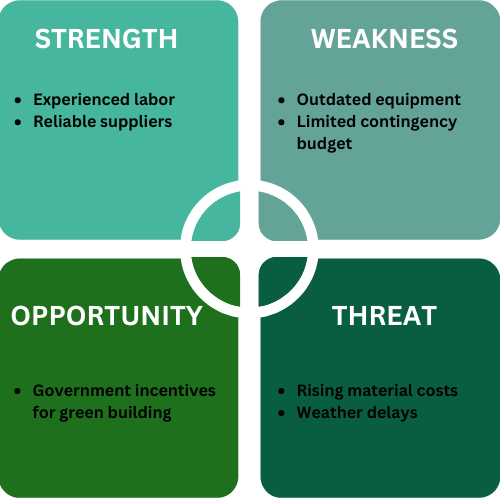
These examples show how SWOT analysis applies to diverse projects, helping teams develop informed strategies.
Templates for SWOT Analysis
Here is a structured template serving as a guide and help you conduct a SWOT analysis for your project.
Project Name:
Date of Analysis:
Team Members Involved:
1. Strengths
(What internal factors give your project an advantage?)
Guiding Questions:
- What skills, resources, or assets do we have that benefit the project?
- What unique capabilities set us apart from competitors?
- What feedback or past successes demonstrate our project strengths?
Examples:
- Highly skilled project team with expertise in the domain.
- Strong stakeholder support and funding.
- Advanced tools or technology already in use.
List Strengths:
1.
2.
3.
2. Weaknesses
(What internal factors are limiting or hindering the project?)
Guiding Questions:
- What gaps exist in our resources or skills?
- Are there inefficiencies in our processes or workflows?
- What feedback or issues have been raised that signal potential weaknesses?
Examples:
- Insufficient budget allocation for the project’s scope.
- Limited experience with new software or technology.
- Communication barriers between departments.
List Weaknesses:
1.
2.
3.
3. Opportunities
(What external factors can positively impact the project?)
Guiding Questions:
- Are there emerging market trends or technologies we can leverage?
- Are there partnerships, incentives, or funding opportunities available?
- How can we align the project with broader organizational goals?
Examples:
- A growing market demand for the product or service.
- Favorable government regulations or incentives.
- Opportunities to expand into new markets.
List Opportunities:
1.
2.
3.
4. Threats
(What external factors could negatively impact the project?)
Guiding Questions:
- Are there competitors launching similar initiatives?
- Are there economic, environmental, or regulatory risks?
- What challenges could arise from stakeholders or external vendors?
Examples:
- Competitors adopting similar technology faster.
- Budget constraints due to rising material or resource costs.
- Regulatory compliance risks that could delay progress.
List Threats:
1.
2.
3.
5. Actionable Strategies
(Develop strategies to act on your SWOT analysis findings.)
- Leveraging Strengths:
- (E.g., Use our skilled team to accelerate project phases.)
- Addressing Weaknesses:
- (E.g., Provide training sessions to close the skill gaps in new technology.)
- Capitalizing on Opportunities:
- (E.g., Apply for government incentives to offset project costs.)
- Mitigating Threats:
- (E.g., Develop contingency plans to handle potential delays caused by competitors.)
6. Next Steps
Create a RACI matrix by defining clear actions, assigning responsibilities, and setting deadlines for executing the strategies.
| Action Item | Responsible Team Member | Deadline |
|---|---|---|
| Example: Schedule training for team | Jane Doe | MM/DD/YYYY |
Tools for SWOT Analysis
Several tools and templates simplify the SWOT analysis process. Popular options include:
- Microsoft Excel or Google Sheets: Ideal for creating basic SWOT matrices.
- Asana or Trello: Useful for visualizing and managing SWOT findings in a collaborative environment.
- Canva or Miro: Great for designing visually appealing SWOT diagrams.
Use a template that aligns with your team’s workflow. Many online tools also allow for easy collaboration and sharing, making them perfect for distributed teams.
Integrating SWOT Analysis with Other Project Management Tools
SWOT analysis works best when integrated with other project management tools and practices:
- Risk Register: Document threats identified in the SWOT analysis and outline mitigation strategies.
- Stakeholder Management Plan: Use insights to engage stakeholders based on their priorities and concerns.
- Change Management Plan: Adjust project plans dynamically as new threats or opportunities arise.
By linking SWOT analysis with other tools, you ensure a comprehensive approach to planning and execution.
SWOT Analysis in Project Management Certifications
For professionals pursuing certifications like PMP or CAPM, SWOT analysis is an essential skill. In the PMP exam, scenarios often require identifying risks, opportunities, and stakeholder priorities. Understanding SWOT analysis can help you excel in these questions.
For CAPM candidates, SWOT analysis is especially useful for learning about the planning phase.
While Agile certifications like PMI-ACP focus less on SWOT, the framework is valuable in hybrid environments or retrospectives for identifying areas of improvement.
Mastering SWOT analysis not only helps with certification exams but also enhances your ability to manage real-world projects effectively.
Conclusion
SWOT analysis is a practical and adaptable tool for project managers. It helps teams uncover insights, improve decision-making, and create strategies to address challenges and seize opportunities.
By integrating SWOT analysis into your project management practices, you can align your team, engage stakeholders, and navigate risks with confidence.
Whether you’re preparing for a certification or managing a complex project, mastering SWOT analysis will elevate your skills and contribute to project success.
FAQ
Can SWOT analysis be used for ongoing projects?
Yes, SWOT analysis is not limited to the initiation or planning phases. It can be revisited throughout the project lifecycle to address changes in internal or external factors. Regular updates help teams stay adaptive and proactive in mitigating risks or leveraging new opportunities.
Can SWOT analysis be used in Agile projects?
Yes, while Agile focuses on iterative workflows and adaptability, SWOT analysis can complement Agile practices. For example, it can be used during retrospectives to identify strengths and opportunities for improvement or at the start of a new sprint to assess external risks and opportunities.
What is the difference between internal and external factors in SWOT analysis?
Internal factors (strengths and weaknesses) are within your project’s control, such as team skills, budget, and processes. External factors (opportunities and threats) are influenced by the outside environment, like market trends, competition, or regulatory changes.
What industries benefit the most from SWOT analysis?
SWOT analysis is widely used across industries, including IT, healthcare, construction, marketing, education, and non-profits. Its adaptability makes it valuable for any field where strategic planning and decision-making are essential.
Can individuals use SWOT analysis for personal development?
Yes, SWOT analysis is often used in personal development to evaluate individual strengths, identify skill gaps, recognize career opportunities, and anticipate potential obstacles. It’s a great tool for career planning or self-assessment.


